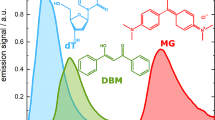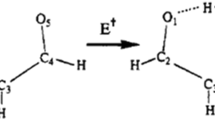Abstract
The complex formation of curium(III) with L2-aminobutyric acid was characterized by time-resolved laser-induced fluorescence spectroscopy (TRLFS) at trace Cm(III) concentrations (3·10−7 M). The various curium(III) species, MpHqLr, identified are characterized by their individual luminescence spectra and luminescence lifetimes. The following formation constants were determined log β101 = 5.17±0.07, log β102 = 9.00±0.07, and log β103 = 11.30±0.09 at ionic strength I = 0.5M. Possible structures of the curium aminobutyrate species will be discussed on the basis of the luminescence lifetime measurements and the magnitude of the formation constants.
Similar content being viewed by others
References
H. Moll, G. Bernhard, J. Coord. Chem., in press.
V. V. Ramanujam, K. Rengaraj, B. Sivasankar, Bull. Chem. Soc. Japan, 52 (1979) 2713.
R. A. Binstead, A. D. Zuberbühler, B. Jung, SPECFIT Global Analysis System Version 3.0.34, 2003.
R. Guillaumont, Th. Fanghänel, J. Fuger, I. Grenthe, V. Neck, D. A. Palmer, M. H. Rand, in: Chemical Thermodynamics 5, Update on the Chemical Thermodynamics of Uranium, Neptunium, Plutonium, Americium and Technetium, F. J. Mompean, M. Illemassene, C. Domenech-Orti, K. B. Said (Eds), OECD Nuclear Energy Agency, Data Bank, Issy-les-Moulineaux, France, Elsevier, 2003, p. 709.
I. Puigdomenech, Input, Sed and Predom: Computer Programs Drawing Equilibrium Diagrams, Trita-OOK-3010, RIT, Stockholm, 1983, Version 29, 2002.
Z. Szabó, F. Grenthe, Inorg. Chem., 39 (2000) 5036.
Th. Fanghänel, J. I. Kim, P. Paviet, R. Klenze, W. Hauser, Radiochim. Acta, 66/67 (1994) 81.
Th. Fanghänel, J. I. Kim, J. Alloys Comp., 271/273 (1998) 728.
W. D. Horrocks Jr., D. R. Sudnick, J. Am. Chem. Soc., 101 (1979) 334.
T. Kimura, G. R. Choppin, J. Alloys Comp., 213/214 (1994) 313.
H. Wimmer, R. Klenze, J. I. Kim, Radiochim. Acta, 56 (1992) 79.
Th. Fanghänel, J. I. Kim, R. Klenze, J. Kato, J. Alloys Comp., 225 (1995) 308.
J. V. Beitz, D. L. Bowers, M. M. Doxtader, V. A. Maroni, D. T. Reed, Radiochim. Acta, 44/45 (1988) 87.
W. T. Carnall, H. M. Crosswhite, Report ANL-84-90, 1995.
I. Grenthe, Acta Chem. Scand., 6 (1963), 1814.
Author information
Authors and Affiliations
Corresponding author
Rights and permissions
About this article
Cite this article
Moll, H., Bernhard, G. Complexation of curium(III) with L2-aminobutyric acid investigated by time-resolved laser-induced fluorescence spectroscopy. J Radioanal Nucl Chem 274, 603–608 (2007). https://doi.org/10.1007/s10967-007-6919-3
Received:
Published:
Issue Date:
DOI: https://doi.org/10.1007/s10967-007-6919-3




